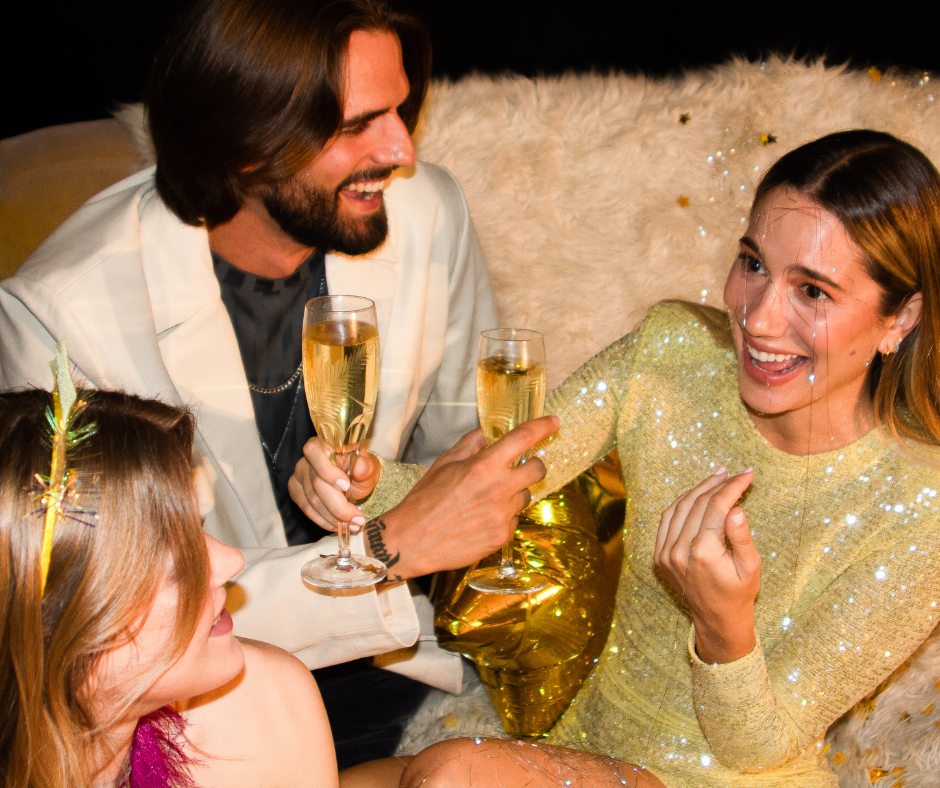
Why We Kiss at Midnight on New Year’s: All About this Endearing Tradition
Summary
Reflection Questions
Journal Prompt
The tradition of kissing at midnight on New Year’s Eve, a custom embraced by many cultures worldwide, signifies the commencement of a new year with a gesture of intimacy and hope. In this article, we explore the historical origins and subsequent evolution of this endearing tradition. Why do we plant that New Year’s Eve kiss on our spouses and other loved ones? Read on to learn more about this sweet New Year’s Eve tradition!
Historical Roots of this Sweet Tradition
The earliest known practices related to New Year’s celebrations date back to ancient civilizations, where the advent of a new year was often marked with rituals and ceremonies of significant importance. In fact, some historians believe that the tradition originated in Ancient Rome or evolved from the sentiments of Auld Lang Syne. These practices varied widely across cultures, with many involving acts of purification, renewal, and homage to deities. These early celebrations set the foundational tone for modern New Year’s traditions, underscoring themes of transition and rejuvenation.
The New Year’s Kiss in German and English Folklore
The tradition of kissing at midnight on New Year’s Eve, as related to English and German folklore, has its roots in customs and beliefs centered around the significance of the New Year. This tradition is a blend of several folklore elements and practices that evolved over centuries.
In English tradition, there’s a belief that the first person you encounter in a new year—and the nature of this encounter—sets the tone for the rest of the year. This concept, known as “First Footing,” was crucial in determining one’s fortune. While not specifically about kissing, it established the importance of one’s actions and interactions at the stroke of midnight. Over time, this evolved into the modern practice of sharing a kiss with a loved one at midnight, symbolizing the strengthening of bonds and ensuring good fortune for the year ahead. British films like Bridget Jones’s Diary continue to feature the kiss as a prominent turning point for lead characters.
Fuel your creative fire & be a part of a supportive community that values how you love to live.
subscribe to our newsletter
*please check your Spam folder for the latest DesignDash Magazine issue immediately after subscription

German traditions also placed a significant emphasis on this night (known as “Silvester”), with various superstitions and rituals. One such belief was that the activities and interactions at the start of the year could influence one’s luck and happiness in the coming year. People kiss at midnight because this act was thought to strengthen relationships and bring good luck. This practice was also seen as a way to ward off evil spirits and negative energies. German immigrants brought the midnight kiss tradition to the United States, and it spread like wildfire!
Both cultures contributed to the idea that the transition from one year to the next was a moment full of magic and potential, where actions taken could influence one’s fate. The act of kissing, being a symbol of affection and connection, was naturally incorporated into these traditions. It was believed to ensure that the bonds of love and friendship would continue strongly into the new year, bringing with it happiness and good fortune.
Midnight Kisses Beyond German and English Tradition

The tradition of kissing at midnight at New Year’s Eve parties has been embraced and modified by various cultures around the world, reflecting a rich tapestry of interpretations and customs. In some Western cultures, this practice is widely observed as a romantic gesture, while in others, it extends to family and friends, symbolizing unity and goodwill. Some lock lips with romantic partners while others kiss the cheeks of estranged friends or platonic family members. Let’s take a closer look at how these traditions have been adapted.
United States and Canada: In North America, particularly in the United States and Canada, the midnight kiss is predominantly a romantic gesture. It’s often portrayed in media and celebrated in public events, like the ball drop in New York City’s Times Square, where crowds gather to kiss at midnight.
Spain and Latin America: In Spain and many Latin American countries, the focus at midnight is often on eating twelve grapes, one for each stroke of the clock at midnight, symbolizing hopes for each month of the coming year. While kissing is not the central tradition, it is still common as a gesture of love and good fortune.
Philippines: In the Philippines, New Year’s Eve is marked by a family-focused celebration. While kissing is not a primary tradition, the emphasis is on unity and joy among family members, with loud celebrations and a variety of local customs.
Japan: In Japan, New Year’s Eve (Ōmisoka) is more about purification and welcoming the New Year with traditions like ringing temple bells 108 times to dispel evils. The concept of a midnight kiss is not a traditional part of these celebrations, though it may be observed by some influenced by Western customs.
Russia: In Russia, New Year’s Eve is a significant celebration, often involving toasts and well-wishing at midnight. While kissing is not inherently a traditional aspect of these celebrations, it is common among couples in a relationship as a sign of affection and hope for a new beginning in the year to come.
Italy: Italians often celebrate with festive gatherings and fireworks. A midnight kiss, though not deeply rooted in Italian tradition, is seen as a way to express love and affection, similar to practices in other Western cultures.
France: In France, New Year’s Eve (La Saint-Sylvestre) is celebrated with a feast (le Réveillon de Saint-Sylvestre), and while the kiss at midnight is not a deeply ingrained tradition, it is commonly practiced among romantic partners.
Denmark and Norway: In these Scandinavian countries, the focus is often on friends and family gatherings, with a focus on togetherness and celebration. Kissing at midnight is common but not a central aspect of the tradition.
Locking Lips at Midnight: The Tradition’s Evolution Over Time
The evolution of the midnight kiss on New Year’s Eve from its original form to the present day reflects broader cultural shifts. Initially rooted in English and German folklore with a focus on superstition and bringing good fortune, the tradition has expanded globally, acquiring new meanings and practices.
In many modern societies, the kiss has transitioned from a superstitious ritual to a symbol of romance and affection on this auspicious night. This shift is indicative of changing societal values, where personal expression and romantic ideals have gained prominence over traditional superstitions.
The Influence of Media and Pop Culture
The influence of media and popular culture has been pivotal in popularizing and modifying the tradition of the New Year’s Eve kiss. Cinematic portrayals like Bridget Jones kissing Mark Darcy and Sally Albright kissing Harry Burns in When Harry Met Sally, television broadcasts of New Year’s celebrations, and social media trends have played significant roles in transforming this custom into a widely recognized and expected event. Media representations often depict the midnight kiss as a romantic, celebratory, and sometimes essential part of ringing in the new year, thereby shaping public perception and expectations about the tradition.
Comparison of Past and Present Celebrations
Comparing past and present-day celebrations reveals notable differences in the observance of the midnight kiss. Historically, the tradition was more closely tied to folklore and communal superstitions, often observed within smaller, community-focused celebrations.
In contrast, contemporary celebrations are characterized by larger, more public and inclusive gatherings, sometimes even in virtual spaces. The kiss, once a more generalized gesture of good fortune among family and friends, has increasingly become associated with romantic love in many cultures. This transition underscores the evolving nature of cultural practices and their adaptation to contemporary societal norms and technologies.
Final Thoughts on the New Year’s Eve Tradition

From its historical roots as a practice steeped in superstition and good fortune, the midnight kiss has transformed into a symbol of romance, love, and hope in many cultures, while still retaining elements of its original intent in others.
The adaptation and popularization of this tradition, heavily influenced by media and popular culture, reflect changing societal values and the power of collective practices in shaping cultural norms. Psychologically, the act of kissing at midnight resonates with the human need for connection and the desire to mark significant life transitions with meaningful gestures. Socially, it highlights the influence of group dynamics and the role of shared traditions in fostering a sense of community and belonging.
The enduring appeal of the New Year’s Eve kiss lies in its ability to blend personal affection with collective celebration. It encapsulates a moment of transition, not just in time, but in the human experience — a simultaneous farewell to the past and a hopeful welcome to the future. In modern celebrations, the midnight kiss continues to hold significance as a poignant reminder of our connections to one another and our shared journey through time.
As we embrace the tradition each year, it serves as a symbol of continuity amidst change and a testament to the enduring human spirit.
Design Dash
Join us in designing a life you love.
10 Design-Forward Menorahs for a Meaningful (and Artful) Hanukkah
Enjoy ten design-forward menorahs that combine ritual and artistry. These objects feel meaningful, intentional, and at home year-round.
5 Designer-Approved Christmas Trees to Inspire Your Holiday Decorating
LIKE 2 LEAVE COMMENT 0 6 min read SummaryThe most compelling Christmas trees don’t focus on chasing trends or achieving perfection; instead, context is key. These five designer-approved trees show how scale, materials, setting, and personality can shape holiday decorating that feels intentional, expressive, and true to its environment, whether playful, restrained, lived-in, or theatrical.…
11 Christmas Paintings to Put You in the Holiday Spirit This Year
Explore 11 Christmas paintings that celebrate the beauty, traditions, and emotions of this festive, fun, and meaningful holiday season.
Styling Spaces Seasonally for Evergreen Portfolio Content + Of-the-Moment Marketing
Learn how interior designers can style spaces seasonally to create both evergreen portfolio images and timely marketing content.
Counting Down Our Most Listened-To Episodes of 2025: Brittny Button
Learn why our conversation with Brittny Button became one of the DesignDash Podcast’s most listened-to episodes of 2025.
10 Finn Juhl Furniture Pieces That Embody Danish Modern Design
As evidenced by these 10 iconic Finn Juhl furniture pieces, he exemplified Danish Modernism through sculptural forms and architectural angles.








